
© Liza Voll, courtesy Jacob’s Pillow Dance. (Click image for larger version)
Nerdy Charm: Dance Heginbotham at Jacob’s Pillow
Dance Heginbotham
Twin, Closing Bell
Jacob’s Pillow, Doris Duke Theatre
8 August 2012
johnheginbotham.com
Once in a while we experience one of those serendipitous evenings in which we show up with few expectations, only to encounter an oasis of structure, understated virtuosity and, best of all, musical intelligence. I had one of those evenings last night at the Doris Duke Theatre at Jacobs Pillow, where I had gone to attend a performance by the six dancers of the fledgling ensemble, Dance Heginbotham.
Though the company’s founder, John Heginbotham, is a relative newcomer to the art of dancemaking – his troupe is but a year old – his choreographic education reaches back more than a decade. Dancers and choreographers learn by watching and doing; since 1998, Heginbotham has had the chance watch Mark Morris at close quarters as a member of his company. During that time he has also collaborated with Susan Marshall, John Jasperse, Pam Tanowitz and others. In other words he has what Baryshnikov calls “impeccable pedigree.”* He has performed innumerable roles in Morris’s company, from Saint Ignatius in his maddening opera-ballet Four Saints in Three Acts to the bartender in the mock-Spanish From Old Seville and a remarkably touching Mrs. Stahlbaum in Morris’s over-the-top Nutcracker tribute, The Hard Nut. Heginbotham has always exhibited a kind of quiet grace onstage, a quality that draws the eye without clamoring for attention. He is comfortable in a dress, never hogs the spotlight, and seems to follow an internal compass, an innate sense of storytelling. These qualities are reflected in his own dances.
He presented two works at the Doris Duke, Twin and Closing Bell, both plotless suites made up of short sections, one for five dancers, the other for four. Both were created in the last year or so. In her genial introductory remarks Ella Baff (the executive director of the Pillow) called it a “nice tidy evening,” and it was. But the description does not capture the antic spirit of the dances. Throughout the program the choreography was inventive, tight, and full of little surprises; one sensed a fertile imagination at work, but also a strong impulse toward discipline. Unlike so many programs by young choreographers, the evening never dragged. Repeated motifs, variations, retrograde phrases, accumulation and counterpoint were used with skill, offering more than enough variety while also creating echoes and connections. The tone was playful – a bit zany, really – without being coy or ingratiating. No Naharin-like blank stares or Keigwin-esque come-hither looks. In fact, the dancers’ demeanor was quite plain, almost nerdy, which, come to think of it, is a bit like Heginbotham himself. A nerdily graceful dancer.
Heginbotham has put together a pleasantly varied group, and puts his dancers’ personal quirks to good use. For the willowy Lindsay Jones, in Twin, he created lots of swinging arms and legs, showing off her Gumby-like flexibility and Pippi-Longstocking charm. She seemed to embody Heginbotham’s willingness to look silly, awkward, odd, but without embarrassment. In the same piece, Michael J. Clark, a boyish dancer with a slightly haunted look, came across as a loner, a yearning figure in a long flowing skirt. He was often set apart, struggling as if trying to get out of a box. At one point he was carried across the stage toward a light, seemingly against his will, mouth open like a figure in a Baroque crucifixion. BJ Randolph – who, during much of Twin, stood completely still – was given a series of luscious jumps in the second piece, Closing Bell, switching direction gorgeously in midair. This was the virtuosic highpoint of the evening, but it was just a moment, which quickly passed. As with Morris, the hands and fingers were very much part of the show; they danced, but also communicated meaning. Eruptions of mime dissolved into abstract patterns. In a particularly pleasing sequence in Closing Bell dancers rose up one by one from a circle on the floor, turned, shot each other with an imaginary pistol, and fell, a never-ending loop of comic-book aggression that mirrored a pattern of blips in the music. At first it was funny, and then – as when one repeats a word over and over – the series of gestures began to lose its meaning. Heginbotham complicated the series in various ways as if trying out all the possible variations of a mathematical problem. It went on just long enough.
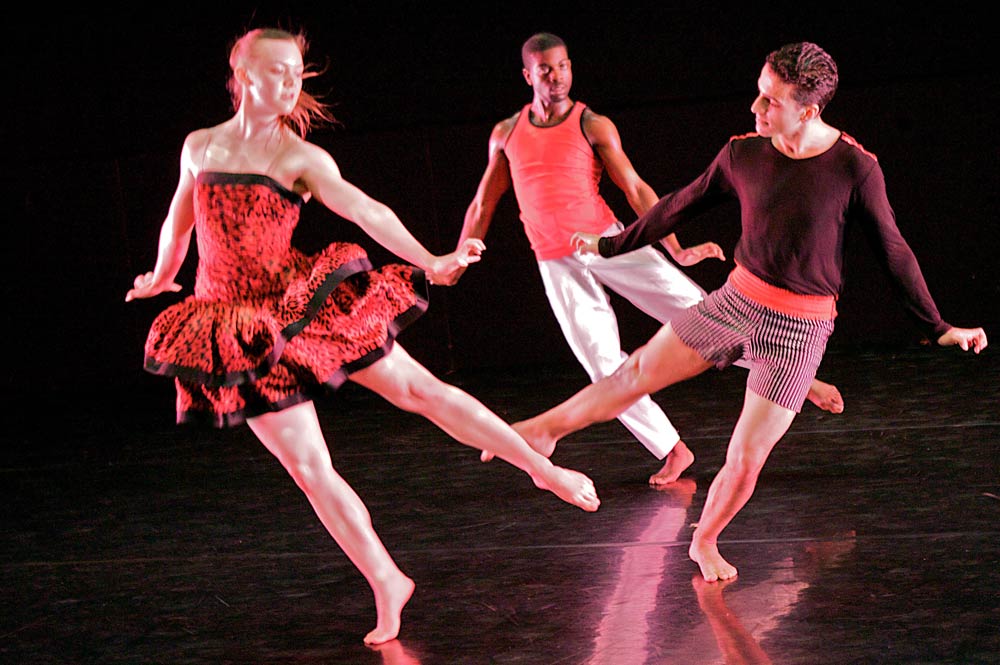
© Amber Star Merkens. (Click image for larger version)
Heginbotham’s choreography for the feet is particularly lively, in a way one seldom sees in modern or postmodern dance, full of syncopated, funny walks, a variety of beaten jumps, and delightful steppy dances that resemble exaggerated jigs and tap-dance routines. (Heginbotham has said that it was Gene Kelly’s dancing that inspired him to seek out lessons). In addition to this folksy element he clearly knows his modern dance history, and makes references – conscious or unconscious – to the accumulations of Trisha Brown, the repetitions of Lucinda Childs, and the throbbing, club-like feel of some contemporary downtown dance. But even more, one senses the influence of the movies: Westerns, zombie flics, cartoons. The costumes, by fellow Morris-ite, Maile Okamura, also have a cartoonish quality, particularly the leotards with bold black-and-white patterns in Twin.
But what makes it all work so well, besides Heginbotham’s oddball sense of humor, is his musicality. Both works on the program are set to giddy electronic scores – Twin uses the infectious British electronica of Aphex Twin, and Closing Bell the more collage-like sounds of Tyondai Braxton. Heginbotham manages to tease out every quirky sound, translating a smeared chord into a heavy dragging step or a repeated jab on the synthesizer into a difficult and precise series of jumps accompanied by a pulsing of the shoulders and arms (impressively executed by Allysen Hooks). He milks every sound and makes you see it. It may look simple, but this kind of close listening is a rare skill, honed over many years of working with one of the most musically-acute choreographers in the business.
Of course, it can also be a trap. There were moments when the movement seemed to fit too neatly into a lock-step with the music, beat-for-beat, note-for-note. It’s not a capital sin, but the ability to work against and across the music is important. There is also the danger of hewing too closely to the Mark Morris model of quirky irreverence, plain-spokenness, conversationalism. I imagine it must be a constant struggle for Heginbotham to break free of the Morris siren-call. But it’s clear that he has his own, fertile imagination, and the craft to put it to good use.
* The quote appears in the “Pillownotes” that come with the program.







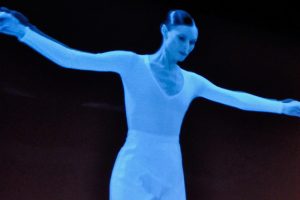
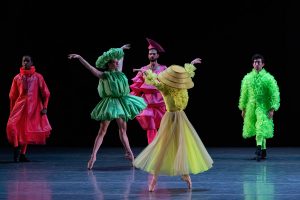

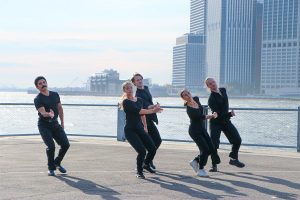


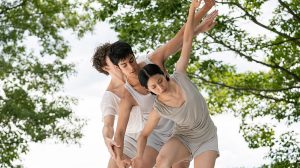

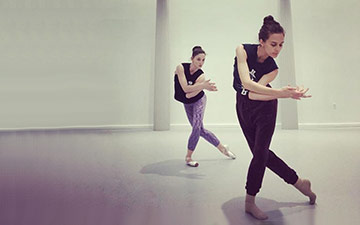

You must be logged in to post a comment.